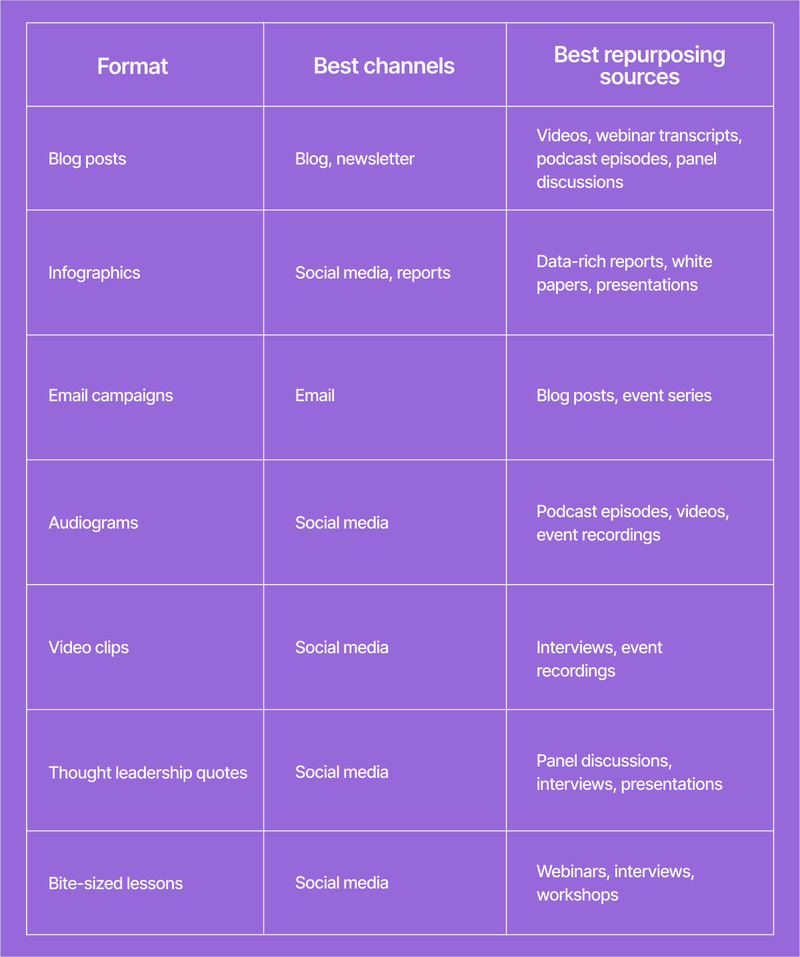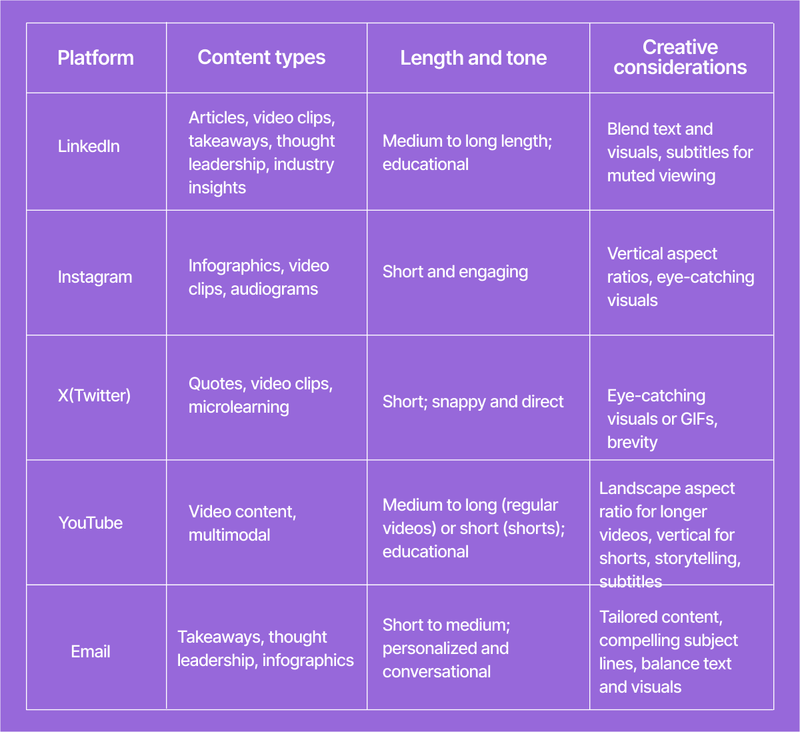How to Create Content Repurposing Workflows that Work

Table of Contents
Maximize Your Marketing ROI
Join 10,000 other marketers already getting the best tips on running engaging events that boost pipeline and create raving fans.
“With ChatGPT, you should be able to create more content in less time.”
🫠 Heard this one recently? With the rise of content-centered AI tools, many marketers are feeling the pressure to create more with fewer resources.
Incorporating AI into your content creation is table stakes. But we know that wrangling AI for the power of good isn’t as simple as throwing out a few prompts. Quality output requires quality input, and one of the best ways to ensure that quality is by starting with an impactful, high-performing piece of content you already have.
In other words: content repurposing.
All the AI tools in the world can’t improve your efficiency or efficacy without a standardized process. So here’s how, exactly, to set up a content repurposing workflow that helps you truly do more with less.
What is a content repurposing workflow?
A content repurposing workflow is a strategic plan that guides marketers in transforming existing content into new formats for new channels.
Having a structured approach to repurpose your content comes with a ton of benefits, including:
- Maximizing the content’s value
- Improving efficiency
- Extending the content’s life
- Reaching new audiences
All of these contribute to the bottom line, increasing your content marketing ROI.
Designing your content repurposing workflow: 7 essential steps
The key to a successful content repurposing workflow is designing it so your team will consistently use it. It should be an enhancement, not a roadblock, to your overarching content process.
You know your internal creation, publish, and promotion processes best, so it’s up to you to design a repurposing workflow that fits in well. That said, there are some fundamental steps to include to give your content the highest impact with an efficient use of resources.
1. Content audit
A content audit is the cornerstone of your repurposing strategy. It helps you identify which content pieces have the highest potential to ensure that you make the best use of your time and resources.
Which types of content should you look at first? Consider these information-dense formats:
- Event materials and recordings. Virtual events produce high-quality content centered on your thought leadership and expertise.
- Long-form video and podcasts. These conversions are rich in insights, making them great candidates to be transformed into content formats like blog posts and social media posts.
- Guides, case studies and white papers. With some creativity, longer written content can be sliced, diced, and repurposed into different formats for different platforms.
By systematically evaluating your existing content, you can prioritize all the right pieces for repurposing.
2. Identify high-engagement content
Flagging your best content will help you pinpoint the topics that truly resonate with your audience. During your audit, dig into metrics like:
- Engagement rates. Gauge the level of audience interaction with your virtual event content to measure how compelling it is.
- Shares. These are the ultimate markers for virality and relevance.
- Watch time. Analyze how long viewers spent on videos and where they dropped off.
- Conversion rates. Pieces that are converting—whether it’s scheduling a demo or downloading a resource—almost always have high repurposing potential.
In addition to consulting your analytics, consider what we know for sure about content consumption. Research shows that the content that gets the most engagement is authentic and interactive.
Look for content with a heavy human element, like expert interviews, panels, and topical deep dives. These are excellent sources for quotes and insights to repurpose.
💡 Pro tip: You don’t have to rewatch your webinar recording three times to identify those heavy-hitting quotes. We promise. An AI-powered video tool can pull them for you in seconds. Here are the prompts SnapLogic uses to automatically source quotes in Goldcast Content Lab.
3. Choose your format
Now that you’ve identified your prime candidates for repurposing, what types of assets will you turn them into? Understanding your audience’s preferences is key here.
Here are a few of our favorite content repurposing formats and where to use them.

While we’ve noted channels for each format above, please know that these are just guidelines. Today, content has evolved and transcended the norms of yesteryear. In the past, written, evergreen content was for the blog. Graphics were for social media platforms. But no more. 🙌🏼
Multimodal content breaks these barriers by combining these formats into an engaging and cohesive experience. Video, text, and graphics unite to form content that’s rich, versatile—and can be used across multiple platforms.
4. The editing process
Repurposing content isn’t just reusing what you already have. Breathing new life into an existing piece of content requires thoughtful editing for a result that’s relevant, cohesive, and high-impact.
Here are our top tips for the editing phase:
- Combine and conquer. Piece together insights from different sources to create a robust asset around a common theme. E.g. Merging stats from several original research reports; highlighting quotes from different speakers across a webinar series.
- Freshen up. As you edit, look for opportunities to incorporate recent data, replace outdated references, and align your content with current trends. (These updates also help with SEO since search engines prioritize up-to-date content.)
- Focus on flow. Go beyond assembly to create something greater than the sum of its parts. Refine transitions, maintain a consistent tone, and do a gut check to make sure each piece aligns with the overarching message.
The editing process is vital to your repurposing workflow and it’s a great opportunity to innovate.
You don’t have to do this manually. AI can help you identify opportunities to slice and dice content so it’s ready for reassembly. Paul Roetzer, Founder of Marketing AI Institute, shares how his team uses AI to repurpose a podcast episode:
“Taking A one-hour podcast and cutting it up into five YouTube shorts or TikTok shorts used to be a highly manual process. You have to find the five segments of the podcast you want, then you have to cut them up, you have to add captions. AI does all that for us now. We have AI in more than half of our podcast steps and it probably saves us about 15 to 20 hours a week.”
5. Tailor for each platform
An extension of editing—and equally crucial—is tailoring your repurposed content to the platform it’s intended for.
Of course, you already know it won’t work to publish your whole blog post on Instagram. But beyond the basics, here are some important nuances to know about each major platform.

Tailoring your content is about meeting audience expectations so that when you show up in their feed or inbox, they’re prepared to engage.
6. Schedule and implement
With a well-oiled content repurposing workflow, you can turn one piece of long-form content into a dozen (or more!) new assets. But timing is everything. ⌚ Unless you’re planning a hyper-focused campaign, you probably won’t want to release all those assets into the wild right away.
Instead, breathe that sigh of relief that only a full content calendar can incite. Marketing automation tools can be your best ally in scheduling out your new content.
These tools—for example, automated social media scheduling—help you map out your content marketing strategy to give each asset its moment to shine while avoiding an overemphasis on any one topic.
7. Monitor, analyze and adapt
The final step of almost any marketing checklist, we can’t overstate the importance of monitoring the effectiveness of your content repurposing strategy and adapting where needed.
Here are a few questions to ask:
- Is our repurposed content reaching the right audience?
- Is it meeting engagement goals?
- Does our workflow have any bottlenecks? Opportunities to increase efficiency?
- What mistakes have happened, and how can we prevent them?
- Which repurposed content has been the most successful? Which fell flat?
By continuing to ask questions and evaluate your processes, you’ll stay agile, effective, and can continue smashing your content marketing goals. 💪🏼
Common content repurposing challenges and how to overcome them
Repurposing content is an art and a science. It can present challenges, especially as audience preferences and content creation tools continue to evolve. Here are a few common challenges and how to address them:
Resource allocation
🔒 The challenge: Time and resources always seem limited, especially for small teams.
🔑 The solution: Prioritize repurposing high-impact pieces and take a good look at ways to streamline your workflow by automating repetitive tasks.
Quality vs. quantity
🔒 The challenge: Producing a high volume of repurposed assets while maintaining quality can be tough.
🔑 The solution: Establish clear quality guidelines and focus on repurposing content that adds value to your target audience — we don’t repurpose just for repurposing’s sake.
Maintaining audience engagement
🔒 The challenge: Overzealous repurposing can lead to audience fatigue if you’re serving the same messages too frequently.
🔑 The solution: If engagement drops on repurposed pieces, revisit the editing and tailoring steps in your workflow to ensure you’re keeping content fresh and providing new value in every piece.
AI and the future of content repurposing
Generative AI can transform the way you approach content repurposing — and many other marketing workflows. However, it can be daunting to figure out where to incorporate AI, and how.
The best advice we’ve seen: Take a look at your current martech stack and determine which tools you’re already paying for have useful AI-powered features. From Sarah McConnell, VP of Demand Generation at Qualified:
“Our first purview as a company was, let’s evaluate our entire tech stack. What do we already have and what are we already paying for? And then figure out how we can utilize their AI functions first, like with Goldcast, make sure we’re working that into our every day before we start to evaluate anything new.”
Optimize your content repurposing workflow with Goldcast Content Lab
Whether you’re just starting to think about a content repurposing workflow or refining yours to perfection, Goldcast Content Lab can help with all the steps above.
How? It’s built on this workflow: One long-form video ➡️ multiple repurposed multichannel assets.
Events, podcasts, and other long-form videos are uniquely insight-rich, but repurposing them manually is arduous, to say the least. Content Lab solves this problem by enlisting AI.
For example, AspenCore produces 10 virtual events per year — but was spending hours repurposing that event footage into social media content. With Content Lab, they’re now clipping videos, creating blog content, and drafting emails in a fraction of the time.
We’re helping B2B marketers save resources and increase ROI every day. Start getting more value from your old content today with Goldcast Content Lab—it’s free!
Transform Your Video Marketing with AI
Stay In Touch
Platform
Resources
© 2025 Copyright Goldcast, Inc. All rights reserved.





 Upcoming Events
Upcoming Events Event Series
Event Series On-Demand Events
On-Demand Events

